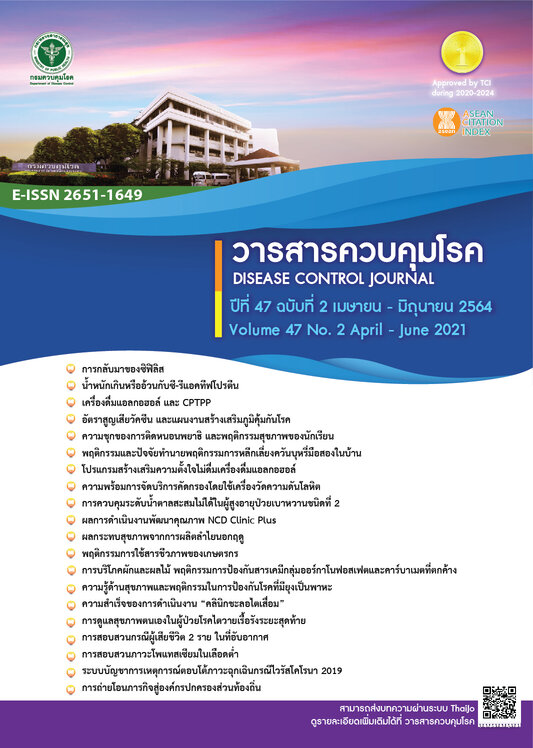Factors predicting farmer’s behavior on biological substances use in Kok-rat sub-district, Kongkailat district, Sukhothai province
DOI:
https://doi.org/10.14456/dcj.2021.29Keywords:
farmer, agricultural chemicals, biological substance, biological substance use behaviorAbstract
This is a descriptive study of the factors associated with and predictive of farmers’ behavior on the use biological substances. The sample group consisted of 279 farmers from Kok-rat sub-district, Kongkrairat district, Sukhothai province, who were included into the study using a cluster sampling method. Data were collected by questionnaires and data analysis by descriptive statistics, which includes percentage, mean, standard deviation, minimum, maximum, and stepwise multiple regression analysis. The study found that knowledge of the type and method of using biological substances, receiving ready-to-use biological or raw materials for making biological substances from agricultural officers, the availability of ready-to-use biological substances or raw materials for biological substance production, and having an agricultural market for biological products are perceived as positive factors by farmers. Having a biological substances learning center and being able to get advice from neighbors or community leaders are also seen as positive factors. Being promoted by agricultural officers, attendance of meetings or seminars about the use biological substances and related occupations are important motivators. All these factors together have a positive relationship with the behavior toward using biological substances with statistical significance at the level of 0.05. The factors that have the power to predict the behavior toward using biological substances are the presence of a biological learning center, receiving of ready-to-use biological substances or the raw materials for making biological substances from agricultural officers. The availability of advice from neighbors or community leaders and agricultural workers have a strong influence on the behavior of farmers and agricultural workers. Together they have resulted in more changes in behavior toward the use of biological substances, which can be predicted at 21.9 percent.
Downloads
References
National Statistical Office. Survey summary Working conditions of the population (April 2017) [Internet]. 2017 [cited 2017 May 14]. Available From: http://www.nso.go.th/sites/2014/DocLib13/ด้านสังคม/สาขาแรงงาน/ภาวะการทำงานของประชากร/2560/Report_April17.pdf (in Thai)
Office of the National Economic and Social Development Council. Quarterly domestic economy [Internet]. 2018 [cited 2019 Mar 29]. Available From: https://www.nesdc.go.th/main.php?filename=qgdp_page (in Thai)
Office of Agriculture Economics. Agricultural Economic Information [Internet]. 2018 [cited 2018 Apr 04]. Available From: http://www.oae.go.th/view/1/ปัจจัยการผลิต/TH-TH (in Thai)
Bureau of Information. Office of The Permanent Secretary of Ministry Of Public Health. Department of Disease Control worried about Thai farmers risk of being poisoned by pesticides along with the principle of "read, put, remove" for safe use of pesticides [Internet]. 2019 [cited 2019 Aug 2]. Available From: https://pr.moph.go.th/?url=pr/detail/2/02/128784/ (in Thai)
Kokrat Subdistrict Administrative Organization. General information. 2016 Annual Report. Sukhothai: Kokrat Subdistrict Administrative Organization; 2017. (in Thai)
Ban Prakrak Health Promoting Hospital. 2015 Inspection pesticide residues in farmers' blood Report. Sukhothai: Ban Prakrak Health Promoting Hospital; 2016. (in Thai)
Highland Research and Development Institute (Public Organization). How to effectively use the biofilament to prevent green wilt of chilli [Internet]. 2020 [cited 2020 Feb 12]. Available From: https://www.hrdi.or.th/articles/Detail/55 (in Thai)
Wayne WD. Biostatitistics: A Foundation of Analysis in the Health Sciences. 6th ed. New Jersey: John Wiley & Sons; 1995.
Siriviriyasomboon N. Study the factors that have an effect on the acceptance of the safe vegetable planting by toxic chemicals of farmers in Bang Yai District, Nonthaburi Province. King Mongkut's Agriculture Journal. 2012;30:59-67. (in Thai)
Ketklomklao P. Health protection skills in using pesticides of farmers Wang Chan Subdistrict Sam Ngao District Tak Province Naresuan University (dissertation). Phitsanulok: Naresuan University; 2010. (in Thai)
Kijteeravutipong N. Public health research: from principles to practice. Phitsanulok: Naresuan University; 2017. (in Thai)
Green LW, Kreuter MW. Health promotion planning: an educational and ecological approach. CA Mayfield: Mountain View; 1999.
Bloom BS. Handbook on Formation and Summative Evaluation of Student Learning. New York: McGraw-Hill; 1971.
Somboon S, Chaikarun S. Biological pesticides to reduce insecticides in the production of peppers. Rajabhat Agriculture Journal. 2011;10:79–89. (in Thai)
Toeihom N. Factors determining farmers' perceptions of pesticide use in Nong Chang District Uthai Thani Province. Journal of Safety and Health. 2018;10:21-32. (in Thai)
Kaopetch R, Tepsilapavisut O. Guidelines for the development of organic guava production process: a case study of guava farmers, Samphan District, Nakhon Pathom Province. Journal of Science and Technology. 2018;26:657-68. (in Thai)
Downloads
Published
How to Cite
Issue
Section
License
Articles published in the Disease Control Journal are considered as academic work, research or analysis of the personal opinion of the authors, not the opinion of the Thailand Department of Disease Control or editorial team. The authors must be responsible for their articles.






